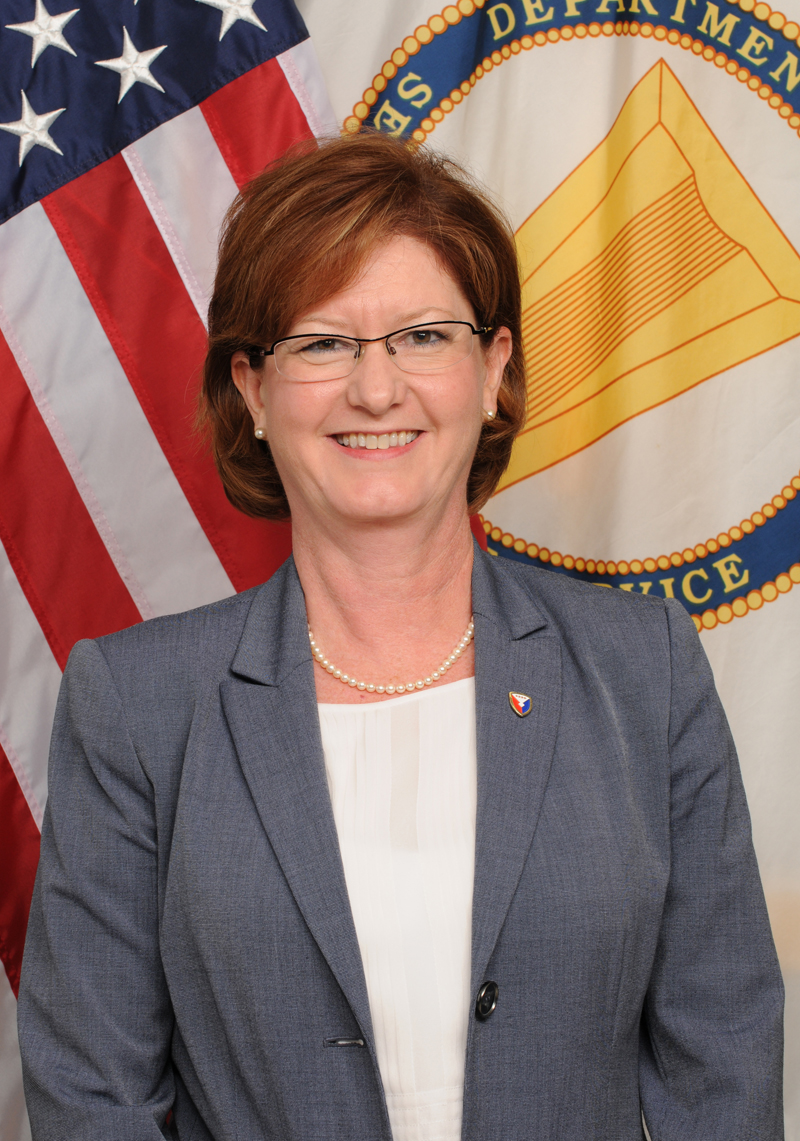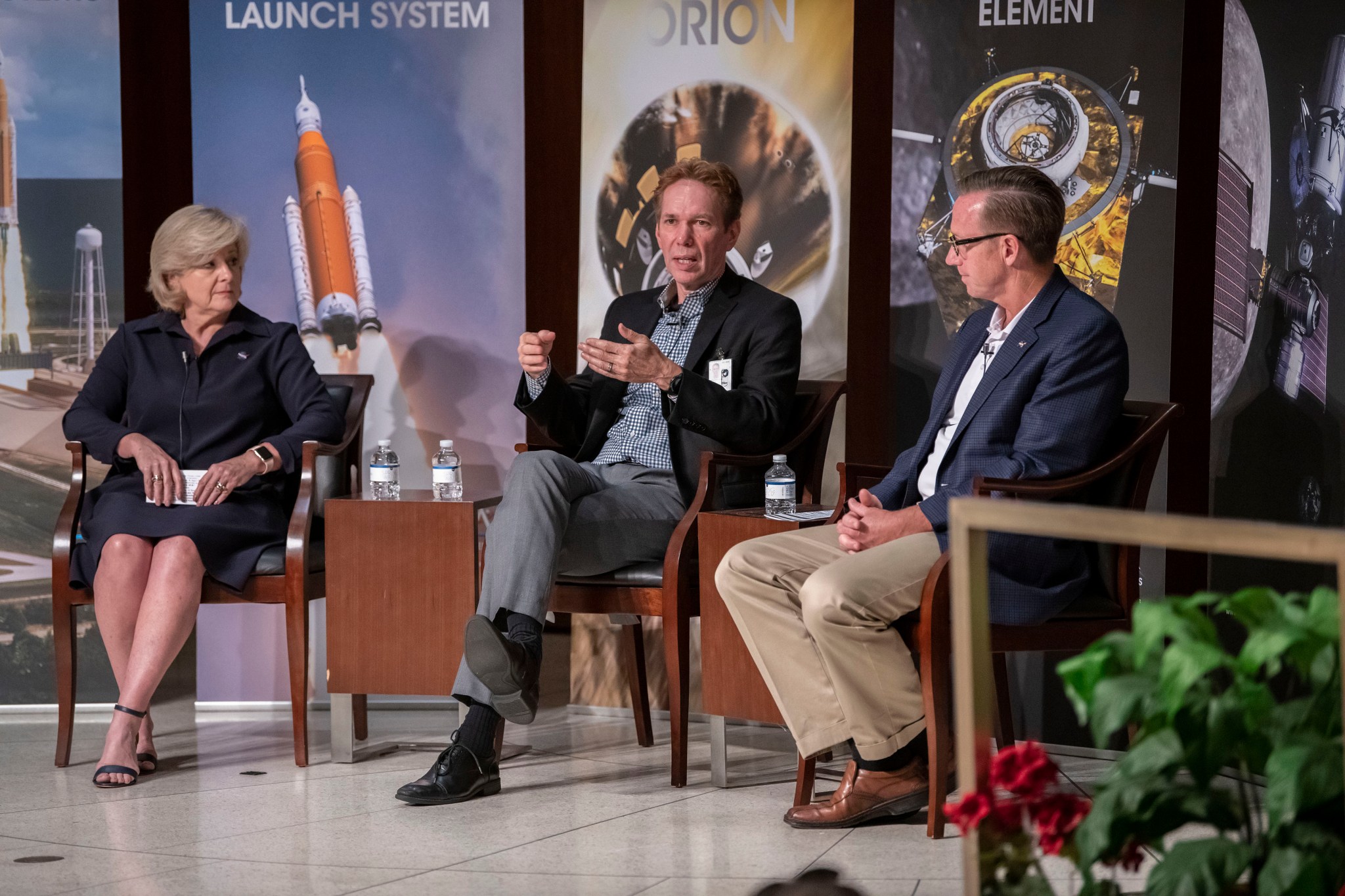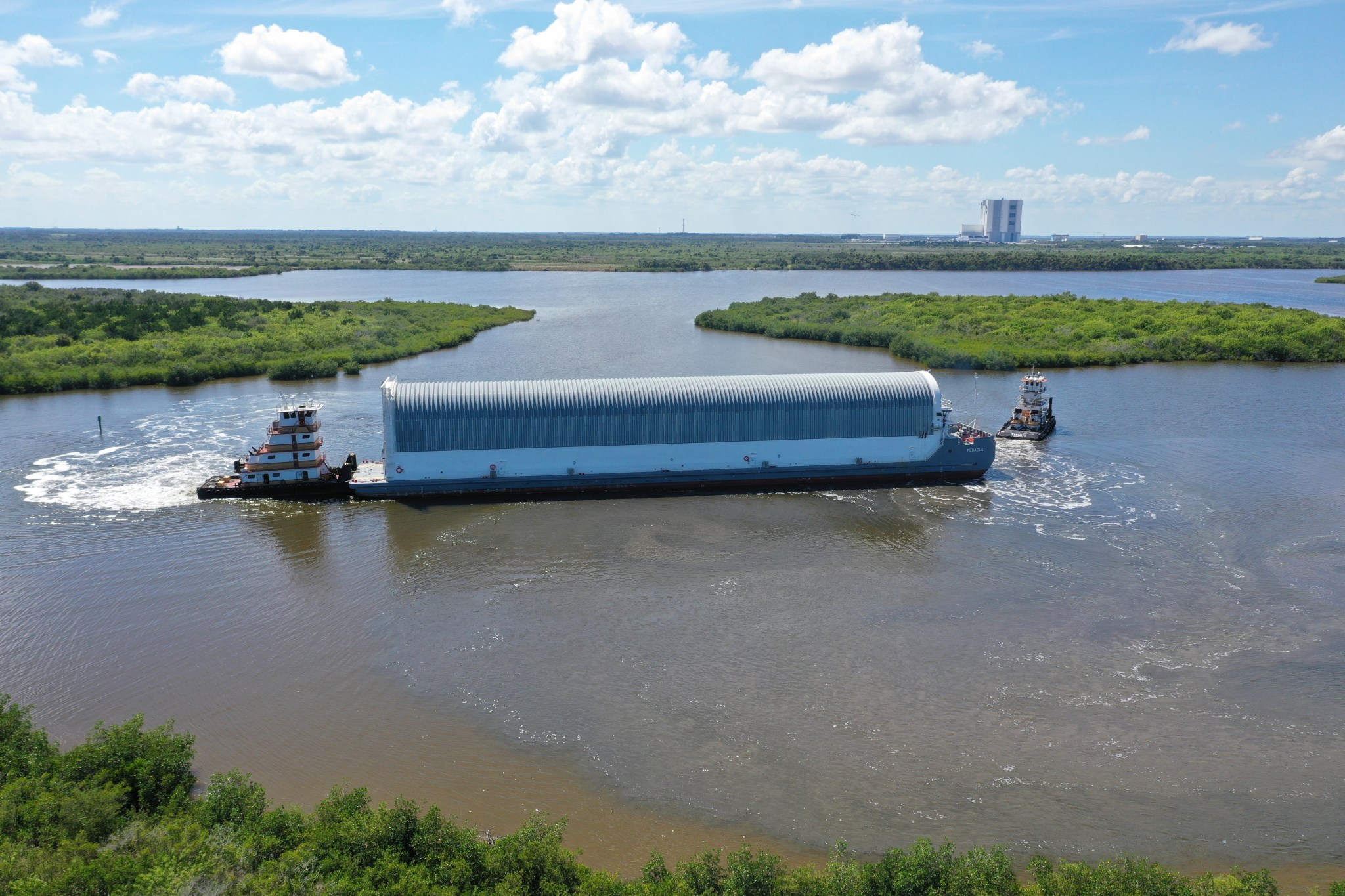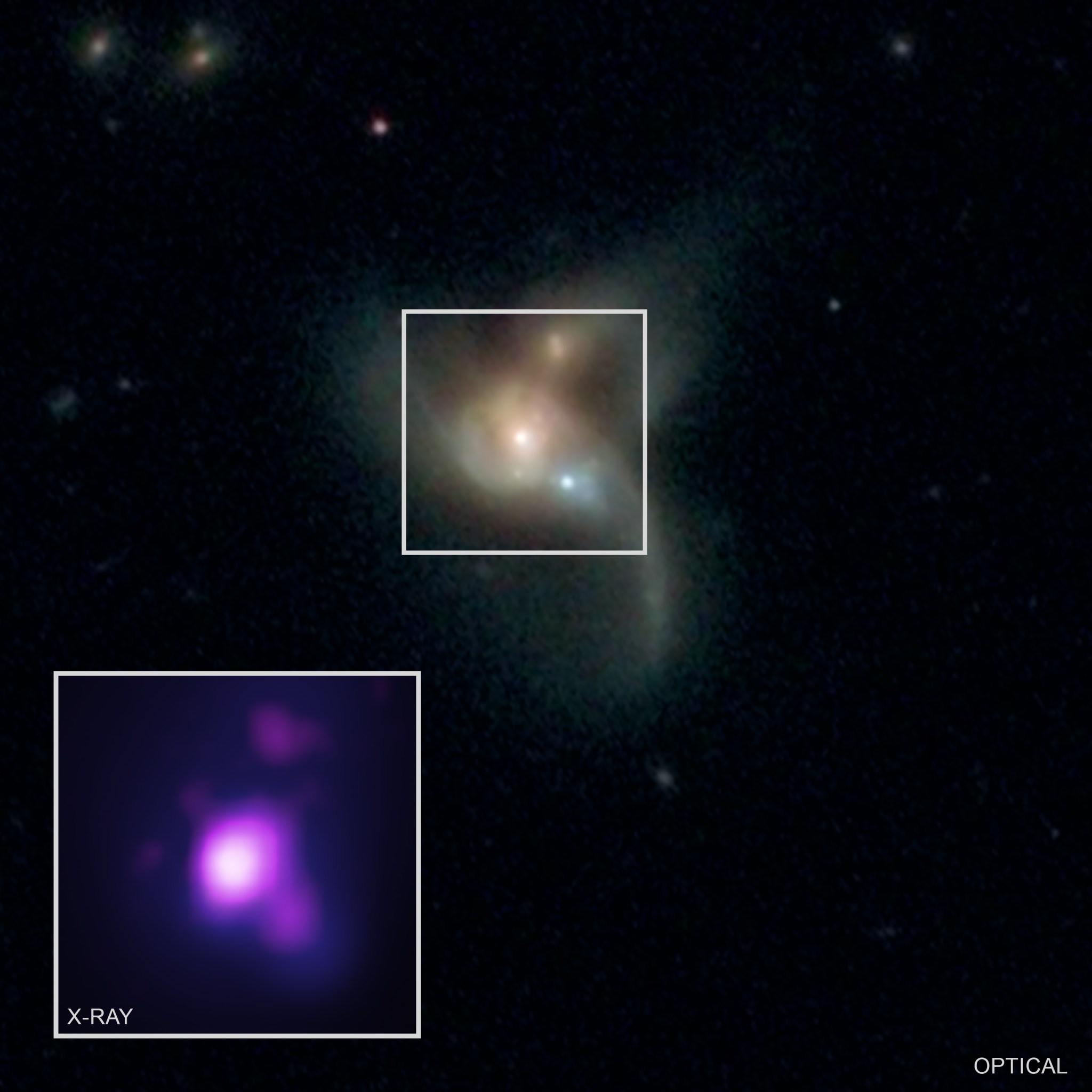In This Week’s Star
- Marshall Mentoring Event Set for Oct. 10; Team Members Encouraged to Attend
- Marshall Director Jody Singer Addresses Team Members at Sept. 27 All-Hands
- NASA, Marshall Recognize Team Members at Honor Awards Ceremonies
- NASA Connects Last of 5 Structures to SLS Rocket Core Stage
- Rocket Pathfinders Prepare Teams for One-of-a-Kind Hardware Prior to Moon Mission
- Found: Three Black Holes on Collision Course
- Marshall Team Invited to Observe the Moon Oct. 5
- Runners, Cyclists Race the Station at Marshall
- Community College Students Explore NASA Careers at Marshall Workshop
- Director of NASA’s Heliophysics Division Visits Marshall
- This Week in NASA History: 1st Flight of Atlantis – Oct. 3, 1985
Marshall Mentoring Event Set for Oct. 10; Team Members Encouraged to Attend
By Adam Farragut
NASA’s Marshall Space Flight Center Deputy Director Paul McConnaughey will lead the mentoring event, “Change: It Happens” from 8 a.m. to noon on Oct. 10 at the Education Training Facility at the U.S. Space & Rocket Center.
“As we begin a new fiscal year, I encourage the Marshall team to make connecting with mentors a priority,” McConnaughey said. “Mentorship offers an invaluable opportunity for personal and professional growth that can have lasting benefits.”
Lisha Adams, U.S. Army Materiel Command’s executive deputy to the commanding general, will deliver the keynote speech about how to cope, react and thrive in a changing environment.
The event will also feature group mentoring panels led by Bobby Watkins, manager of Marshall’s Human Exploration Development and Operations Office; Neil Rodgers, director of Marshall’s Chief Information Office; Denise Smithers, deputy director of Marshall’s Office of Diversity and Equal Opportunity; and Matt McSavaney from the Marshall Early Career Group. Speed mentoring opportunities will be available with Cheryl Harrell, manager of the Space Launch System’s Planning and Control Office; Angelia Walker, deputy director of Marshall’s Spacecraft and Vehicle Systems Department; and Davey Jones, Integration & Development lead for the Environmental Control and Life Support System.
For more information and registration, visit Satern.
Farragut, an ASRC Federal/Analytical Services employee, supports Marshall’s Office of Strategic Analysis & Communications.
Marshall Director Jody Singer Addresses Team Members at Sept. 27 All-Hands
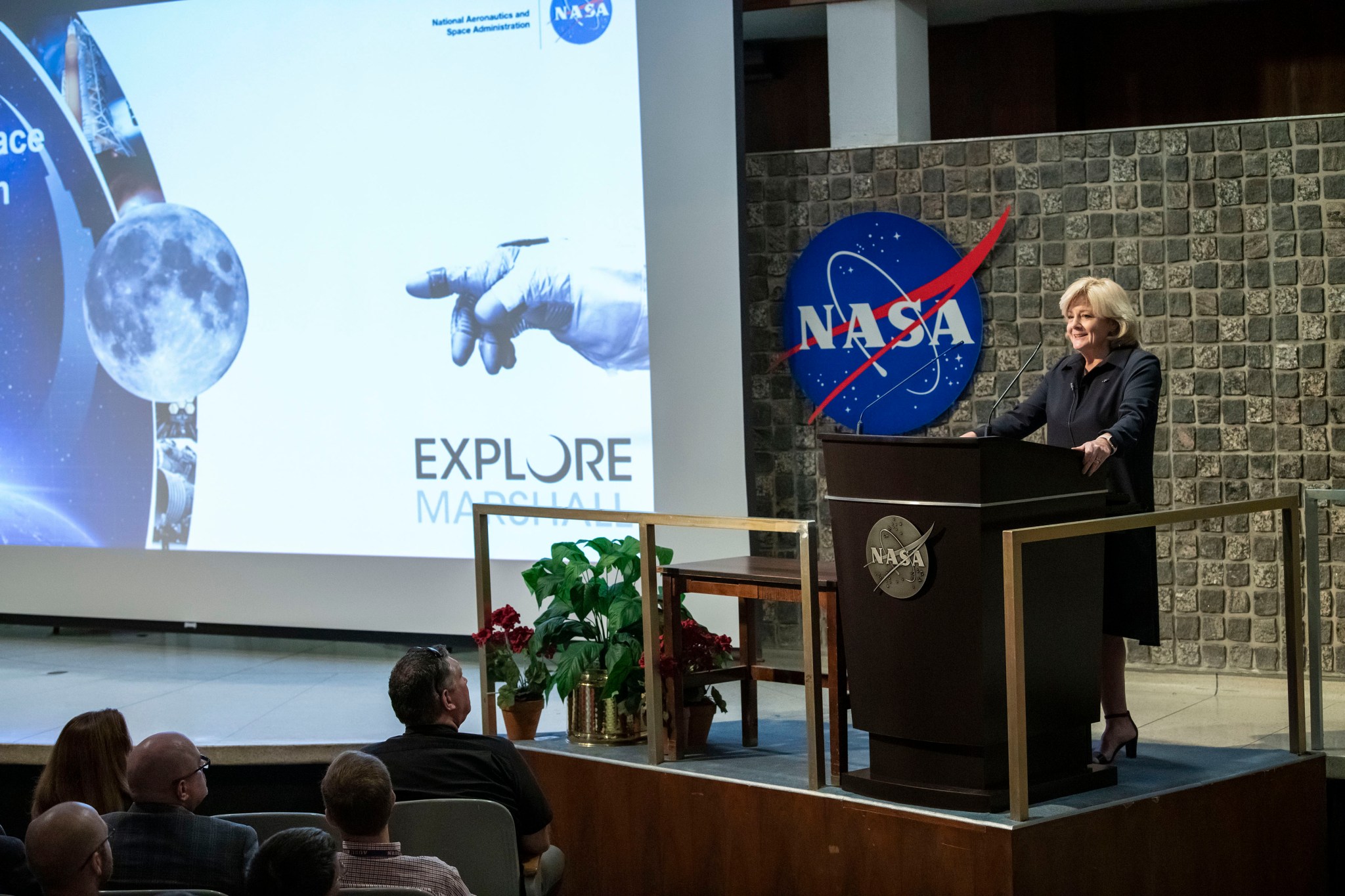
NASA’s Marshall Space Flight Center Director Jody Singer addresses the Marshall team at a Sept. 27 all-hands meeting. Singer touched on a number of topics, including Artemis progress, the upcoming NASA fiscal year 2020 budget, recent Marshall leadership changes, the workforce and the center’s plan to thrive moving forward into fiscal year 2020. Lisa Watson-Morgan, manager for the Human Landing System Program, and Chris Cianciola, deputy manager for the Space Launch System Program, also gave program updates. (NASA/Fred Deaton)
Marshall Deputy Director Paul McConnaughey, center, answers a question from a Marshall team member during a Q&A session with Singer, left, and Marshall Associate Director Steve Miley. (NASA/Fred Deaton)
NASA, Marshall Recognize Team Members at Honor Awards Ceremonies
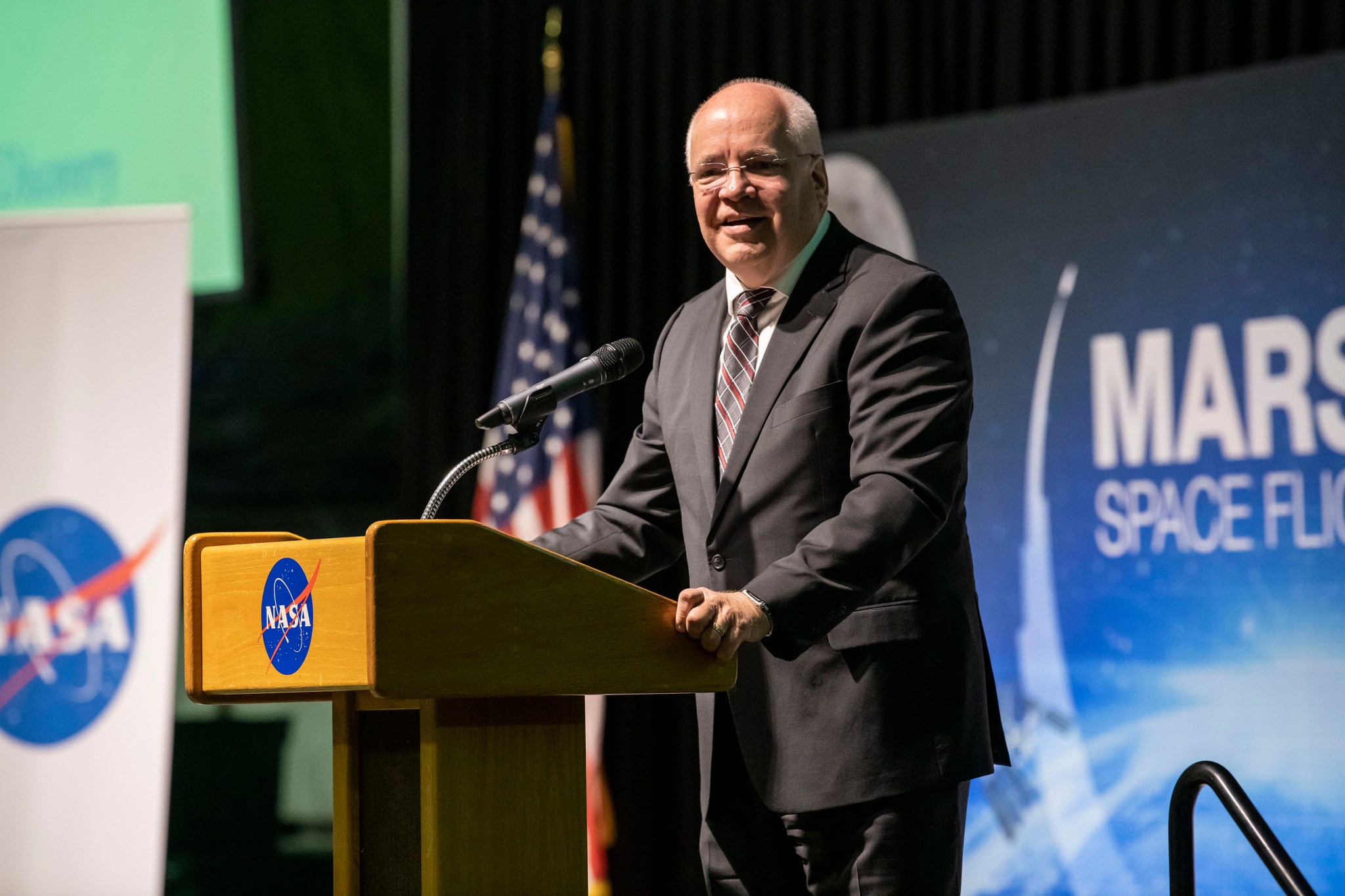
Dennis Andrucyk, deputy associate administrator for NASA’s Science Mission Directorate, delivers the keynote address at the annual Honor Awards ceremonies Sept. 25 in Activities Building 4316. “What we do is not easy,” he said. “The recognition given today is truly deserved for all of the hard work and dedication that goes into our mission.” More than 300 Marshall civil servants, contractors and teams were recognized for their contributions. “It is always one of the most fun times of the year when we celebrate the men and women who exemplify this year’s theme: ‘Illuminating the Path to Discovery,’” Marshall Director Jody Singer said. “I am honored to have each of you on my team.” For a list of the NASA Honor Awards, click here. For a list of Marshall Honor Awards, click here. (NASA/Fred Deaton)
NASA Connects Last of 5 Structures to SLS Rocket Core Stage
NASA finished assembling and joining the five main structural components for the agency’s Space Launch System rocket core stage at NASA’s Michoud Assembly Facility on Sept. 19. Technicians from NASA and Boeing, the core stage lead contractor, bolted the engine section to the stage’s liquid hydrogen propellant tank that will help send Artemis I, the first flight of SLS and NASA’s Orion spacecraft, to the Moon. The engine section, located at the bottom of the 212-foot-tall stage, is one of the most complicated pieces of hardware for the SLS rocket and is a crucial attachment point for the four RS-25 engines and two solid rocket boosters that produce a combined 8.8 million pounds of thrust. This fall, NASA will work with Boeing and Aerojet Rocketdyne, the RS-25 engine lead contractor, to attach the four RS-25 engines to the stage and connect them to the main propulsion systems inside the engine section. For more information about SLS, visit here. (NASA)
Rocket Pathfinders Prepare Teams for One-of-a-Kind Hardware Prior to Moon Mission
NASA’s Pegasus barge arrived Sept. 27 at the agency’s Kennedy Space Center with the core stage pathfinder for NASA’s Space Launch System rocket. The pathfinder will be used for lift and transport practice techniques inside Kennedy’s Vehicle Assembly Building to prepare for the first lunar mission of SLS and NASA’s Orion spacecraft, Artemis I.
The core stage pathfinder is one of three pathfinder structures used by NASA to train lift crews on best practices for moving and handling the SLS rocket flight hardware. In addition to the core stage pathfinder, there is an RS-25 engine pathfinder and a solid rocket booster pathfinder. Designed as full-scale mockups of the flight hardware, the three SLS pathfinders each reflect the shape and size of the individual components of the rocket.

The number of pathfinders for the rocket allow multiple teams to use the pathfinders for different operations and procedures at several processing locations. After teams at Kennedy practice with the core stage pathfinder in the VAB, NASA’s Exploration Ground Systems will begin stacking operations with the booster pathfinder structures to simulate an aft booster assembly and bottom center segment stacking operation. All this practice prepares teams for the same upcoming tasks with the actual flight hardware.
Engineers previously used the core stage pathfinder in August at NASA’s Stennis Space Center, where crews practiced similar lift and handling procedures into the B-2 Test Stand ahead of the Green Run test series for the core stage.
“Among other things, the exercise helped us identify minor facility modifications early enough to provide the time needed to make the corrections prior to the arrival of the core stage flight hardware,” said Barry Robinson, B-2 Test Stand core stage test project manager at Stennis.
Equipped with the largest rocket stage NASA has ever produced and the largest twin boosters ever built for flight, the SLS rocket for the Artemis missions will be the most powerful rocket in the world, enabling astronauts in Orion to travel to the Moon’s south pole. The two massive propellant tanks in the rocket’s 212-foot-tall core stage power the four RS-25 engines at the bottom of the rocket. On either side of the core stage are two, five-segment solid rocket boosters. Together, the engines and the boosters will produce a combined thrust of 8.8 million pounds during launch and flight. The rocket for Artemis I will tower at 322 feet.
“Practicing operations with pathfinders offers teams hands-on experience for managing and handling the immense structures before this one-of-a-kind flight hardware arrives,” Robinson said.
Because the pathfinders replicate the flight hardware, the various pathfinders validate ground support equipment, and flight hardware access techniques as well as train handlers to transport the equipment on a variety of terrains with different vehicles, like the Pegasus barge and Kennedy’s mobile launcher, and demonstrate how the equipment can be integrated within facilities.
“Experience is the best teacher,” said Jim Bolton, Exploration Ground Systems core stage operations manager. “Pathfinders allow crews to practice lifting, accessing and transporting techniques that we prefer not to do for the first time with the flight hardware. Practicing with a pathfinder reduces risks and builds confidence.”
Completed flight hardware for SLS and Orion will also be delivered as crews at Kennedy use the SLS booster and core stage pathfinders for the same processes the actual flight hardware will undergo when processed at Kennedy for Artemis I.
“NASA’s first Artemis mission flight hardware has progressed into final assembly and integration, moving well beyond the early design and manufacturing stages of development,” said Mark Prill, SLS core stage pathfinder lead. “Flight hardware for both the SLS rocket and the Orion spacecraft will continue to be delivered to Kennedy as NASA prepares for the launch of Artemis I.”
Found: Three Black Holes on Collision Course
Astronomers have spotted three black holes within a collision of three galaxies. Several observatories, including three NASA space telescopes, detected the unusual system.
“We were only looking for pairs of black holes at the time, and yet, through our selection technique, we stumbled upon this amazing system,” said Ryan Pfeifle of George Mason University in Fairfax, Virginia, author of a paper in The Astrophysical Journal describing the results. “This is the strongest evidence yet found for such a triple system of actively feeding supermassive black holes.”
The system, located a billion light years from Earth, is known as SDSS J084905.51+111447.2 (SDSS J0849+1114).
To uncover this rare trifecta, researchers combined data from both ground and space telescopes. First, the Sloan Digital Sky Survey telescope, which scans large swaths of sky in optical light from New Mexico, imaged SDSS J0849+1114. With the help of citizen scientists participating in a project called Galaxy Zoo, it was tagged as a system of colliding galaxies.
Then data from NASA’s Wide-field Infrared Survey Explorer mission revealed that the system was glowing intensely in infrared light during a phase in the galaxy merger when more than one of the black holes is expected to be feeding rapidly. Astronomers then turned to the Chandra X-ray Observatory, managed by NASA’s Marshall Space Flight Center, and the Large Binocular Telescope in Arizona.
The Chandra data revealed X-ray sources — a sign of material being consumed by black holes — at bright centers of each galaxy in the merger. Chandra and NASA’s Nuclear Spectroscopic Telescope Array also found evidence for large amounts of gas and dust around one of the black holes, typical for a merging black hole system.
Meanwhile, optical light data from the Sloan Digital Sky Survey and Large Binocular Telescope showed characteristic spectral signatures of material being consumed by the three supermassive black holes.
“Optical spectra contain a wealth of information about a galaxy,” said co-author Christina Manzano-King of University of California, Riverside. “They are commonly used to identify actively accreting supermassive black holes and can reflect the impact they have on the galaxies they inhabit.”
One reason it is difficult to find a triplet of supermassive black holes is that they are likely to be shrouded in gas and dust. The infrared images from the Wide-field Infrared Survey Explorer, the infrared spectra from the Large Binocular Telescope and the X-ray images from Chandra bypass this issue, because infrared and X-ray light pierce clouds of gas much easier than optical light.
“Through the use of these major observatories, we have identified a new way of identifying triple supermassive black holes,” Pfeifle said. “Each telescope gives us a different clue about what’s going on in these systems. We hope to extend our work to find more triples using the same technique.”
“Dual and triple black holes are exceedingly rare,” said co-author Shobita Satyapal, also of George Mason, “but such systems are actually a natural consequence of galaxy mergers, which we think is how galaxies grow and evolve.”
Three supermassive black holes merging behave differently than a pair. When there are three such black holes interacting, a pair should merge into a larger black hole faster than if the two were alone. This may be a solution to a theoretical conundrum called the “final parsec problem,” in which two supermassive black holes can approach to within a few light-years of each other, but would need some extra pull inwards to merge because of the excess energy they carry. The influence of a third black hole, as in SDSS J0849+1114, could join them.
Computer simulations have shown that 16% of pairs of supermassive black holes in colliding galaxies will have interacted with a third supermassive black hole before they merge. Such mergers will produce ripples through spacetime called gravitational waves. These waves will have lower frequencies than the National Science Foundation’s Laser Interferometer Gravitational-Wave Observatory and European Virgo gravitational-wave detector can sense. However, they may be detectable with radio observations of pulsars, as well as future space observatories, such as the European Space Agency’s Laser Interferometer Space Antenna, which will detect black holes up to one million solar masses.
The Smithsonian Astrophysical Observatory’s Chandra X-ray Center controls science and flight operations from Cambridge, Massachusetts.
Marshall Team Invited to Observe the Moon Oct. 5

Team members from NASA’s Marshall Space Flight Center are invited to celebrate International Observe the Moon Night from 5:30-8:30 p.m. Oct. 5. NASA’s Planetary Missions Program Office, managed by Marshall, hosts this family friendly event in the U.S. Space & Rocket Center’s Davidson Center for Space Exploration. Admission is free. International Observe the Moon Night is an annual public event that encourages observation, appreciation and understanding of our Moon and its connection to NASA planetary science and exploration. The event connects scientists, educators and lunar enthusiasts from around the world. (NASA)
Runners, Cyclists Race the Station at Marshall
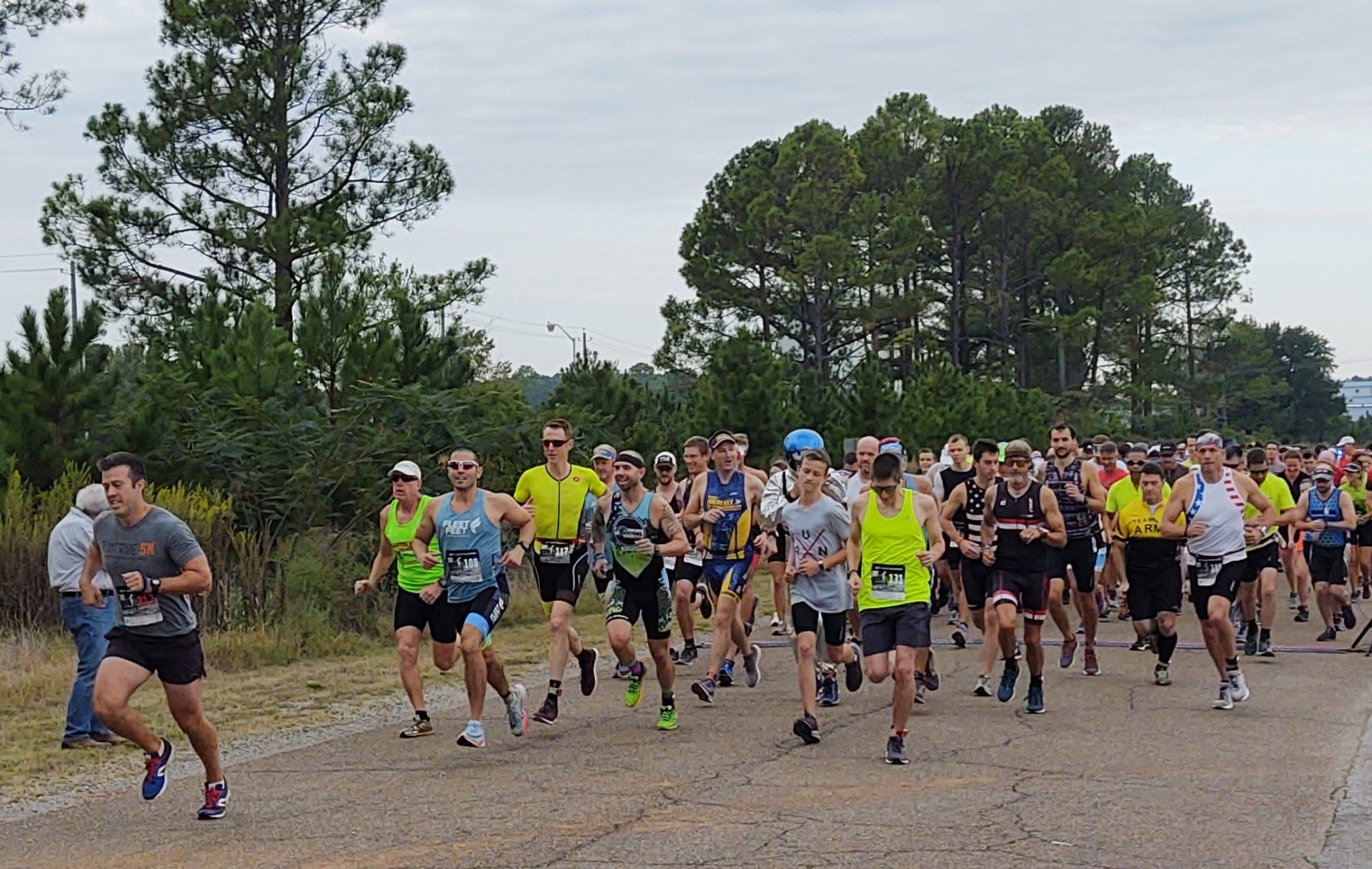
A group of 200 athletes from seven states compete in the 8th annual Racin’ the Station duathlon Sept. 28 at NASA’s Marshall Space Flight Center. The event consists of a 3.14-kilometer run, a 25-kilometer bike ride and one final 3.14-kilometer run. The goal is to finish the course before the International Space Station completes an orbit around Earth in 91 minutes and 12 seconds. Proceeds from the race, hosted by Huntsville Team Rocket Tri Club, fund the Marshall Association’s scholarship fund. (NASA/Will Bryan)
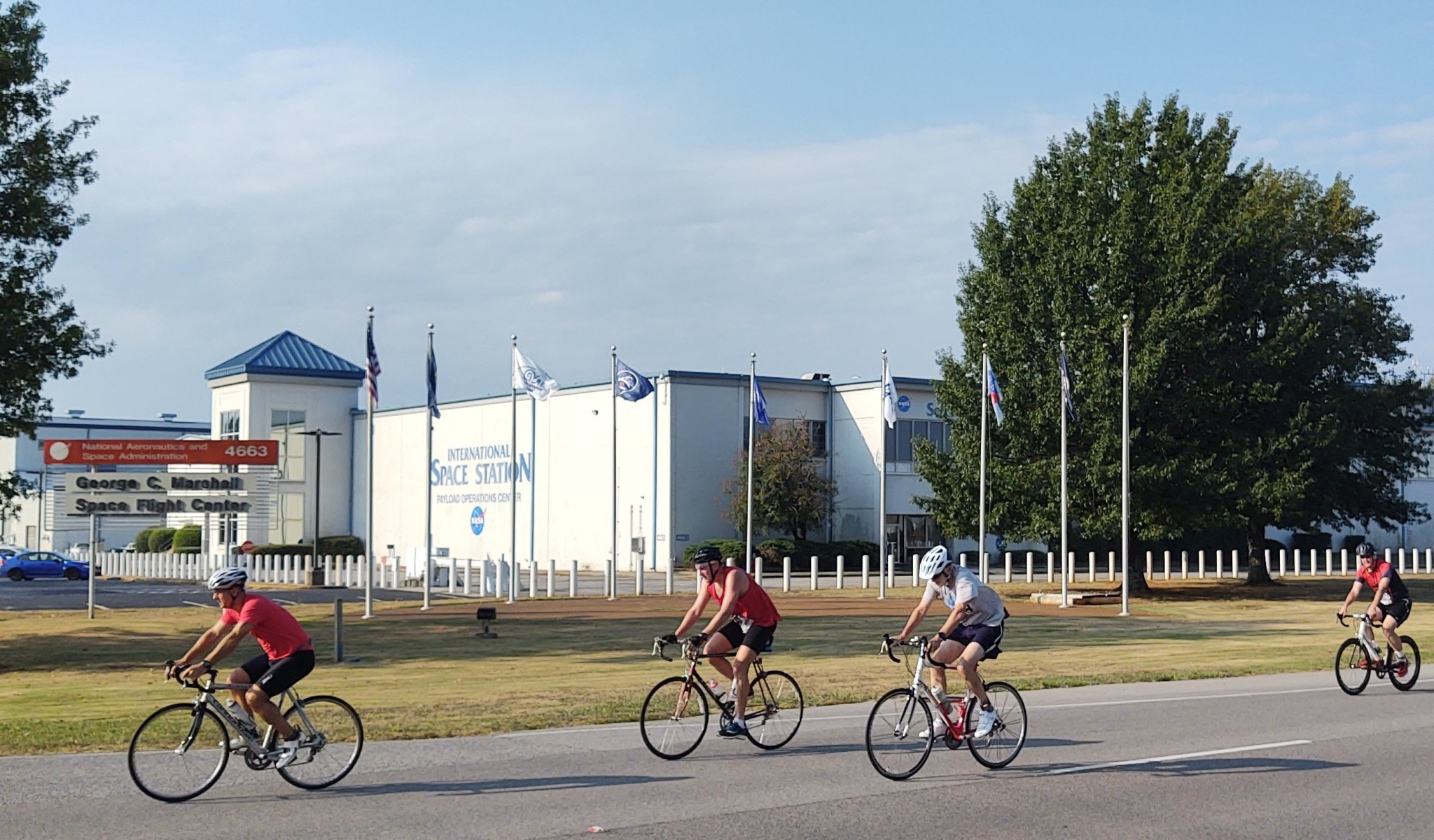
Cyclists pass Marshall’s Payload Operations Center in the second leg of the 2019 Racin’ the Station duathlon. Participants could choose to compete in two-person relay teams, passing off the running and cycling legs of the race, or to complete the entire race as an individual. A total of 104 individuals and teams successfully beat the station this year. Nathan Pierce of Huntsville had the fastest time for the second consecutive year, completing the course in 1 hour, 51 seconds. (NASA/Will Bryan)
Community College Students Explore NASA Careers at Marshall Workshop
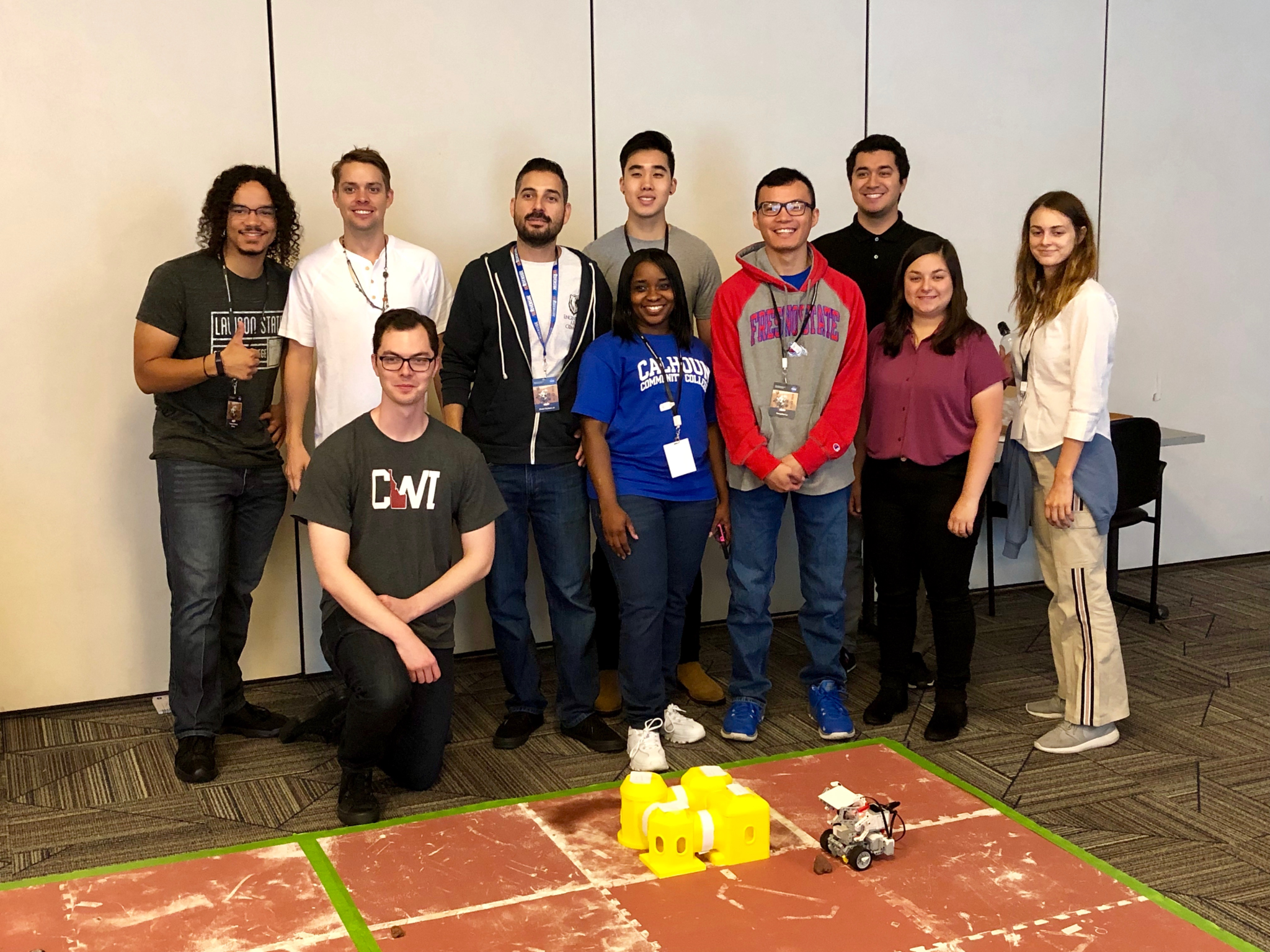
Participants in this year’s NASA Community College Aerospace Scholars workshop display their robotic rover and 3D-printed model habitat after competing Sept. 25 at Marshall’s Education Training Facility at the U.S. Space & Rocket Center. Forty students from 31 schools across the United States attended the week-long workshop, which included networking opportunities with Marshall employees, learning about NASA careers and taking part in team competitions building and programming robots to autonomously pick up samples on a replica Martian surface. Applications for the spring 2020 NCAS class are open through Oct. 16; all U.S. community college students with nine-plus hours of science, technology, engineering and math coursework and an interest in NASA are encouraged to consider applying. (NASA/Brice Russ)
Director of NASA’s Heliophysics Division Visits Marshall
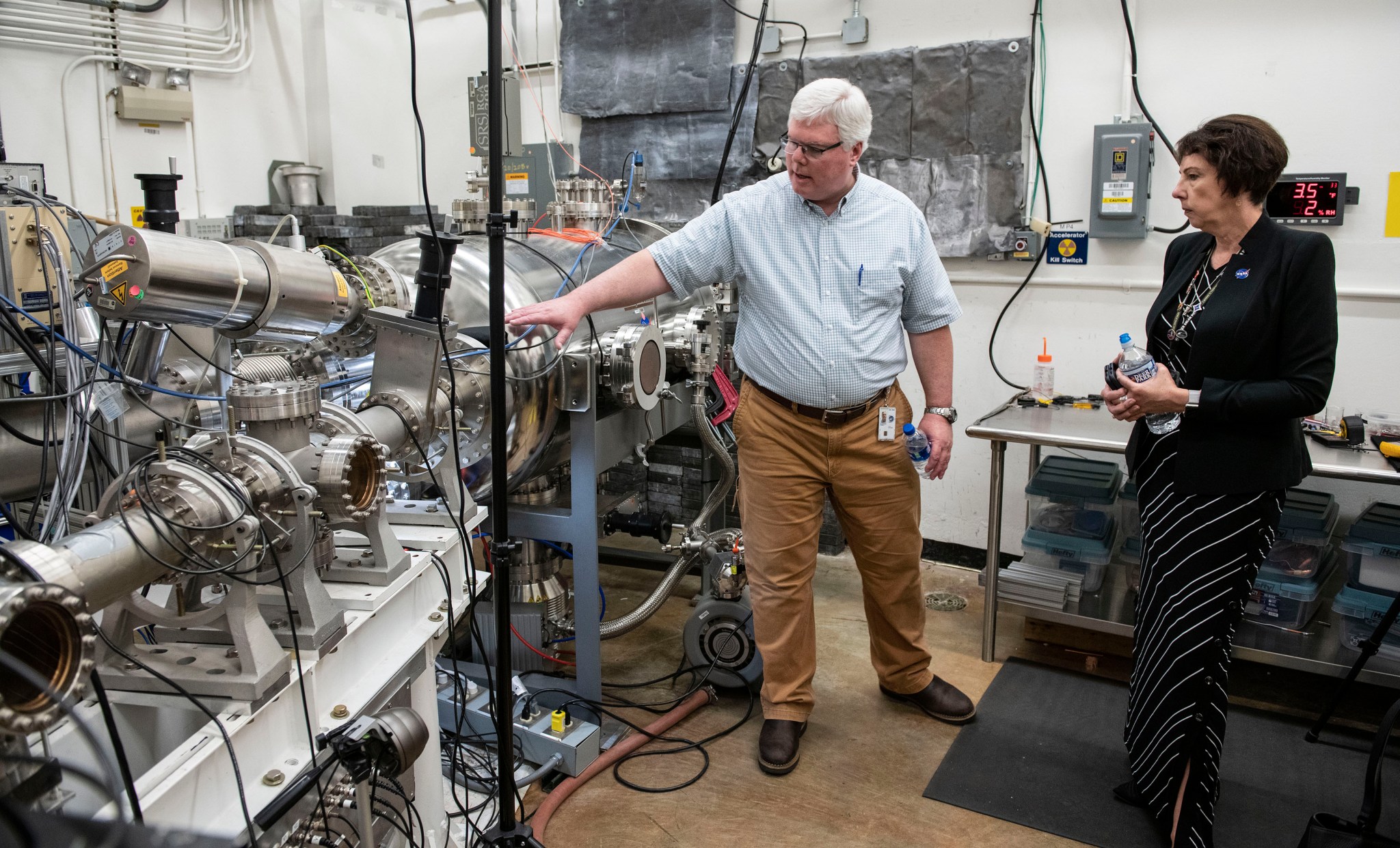
Nicola Fox, director of NASA’s Heliophysics Division, right, hears from NASA’s Marshall Space Flight Center physicist Todd Schneider during her visit to the center Sept. 26. Fox toured multiple facilities at Marshall — including the Space Environmental Effects facility — to see firsthand how Marshall scientists and engineers are advancing exploration and discovery. (NASA/Fred Deaton)
This Week in NASA History: 1st Flight of Atlantis – Oct. 3, 1985
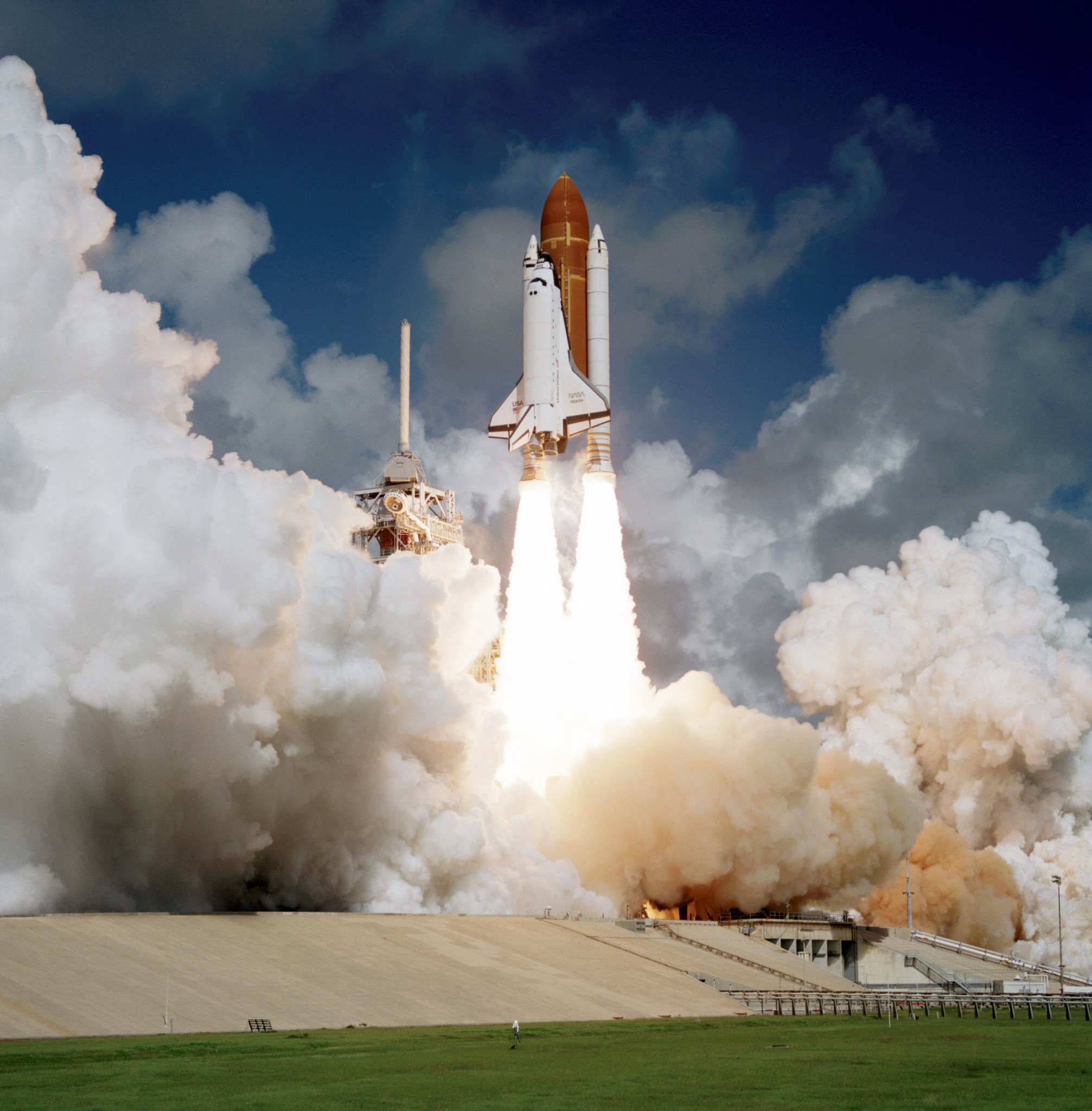
This week in 1985, space shuttle Atlantis, mission STS-51J, launched on its maiden voyage from NASA’s Kennedy Space Center. This was the second shuttle mission dedicated to the Department of Defense. The five-member crew safely landed at Edwards Air Force Base following their four-day mission. The NASA History Program is responsible for generating, disseminating and preserving NASA’s remarkable history and providing a comprehensive understanding of the institutional, cultural, social, political, economic, technological and scientific aspects of NASA’s activities in aeronautics and space. For more pictures like this one and to connect to NASA’s history, visit the Marshall History Program’s webpage. (NASA)





























